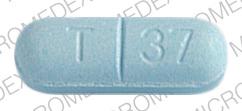Talacen and Alcohol/Food Interactions
There is 1 alcohol/food/lifestyle interaction with Talacen (acetaminophen / pentazocine).
Pentazocine Food/Lifestyle
Major Food Interaction
GENERALLY AVOID: Alcohol may potentiate the central nervous system (CNS) depressant effects of opioid analgesics including pentazocine. Concomitant use may result in additive CNS depression and impairment of judgment, thinking, and psychomotor skills. In more severe cases, hypotension, respiratory depression, profound sedation, coma, or even death may occur.
MONITOR CLOSELY: Smoking tobacco may decrease the plasma concentrations and effects of pentazocine by enhancing its metabolic clearance.
MANAGEMENT: Patients should not consume alcoholic beverages or use drug products that contain alcohol during treatment with pentazocine. Any history of alcohol or illicit drug use should be considered when prescribing pentazocine and therapy initiated at a lower dosage if necessary. Patients should be closely monitored for signs and symptoms of sedation, respiratory depression, and hypotension. Additionally, the possibility of reduced therapeutic effects of pentazocine should be considered if smoking cannot be avoided.
References (4)
- Miller LG (1989) "Recent developments in the study of the effects of cigarette smoking on clinical pharmacokinetics and clinical pharmacodynamics." Clin Pharmacokinet, 17, p. 90-108
- D'Arcy PF (1984) "Tobacco smoking and drugs: a clinically important interaction?" Drug Intell Clin Pharm, 18, p. 302-7
- (2024) "Product Information. Naloxone HCl-Pentazocine HCl (naloxone-pentazocine)." Actavis U.S. (Amide Pharmaceutical Inc)
- Cherrier MM, Shen DD, Shireman L, et al. (2021) "Elevated customary alcohol consumption attenuates opioid effects." Pharmacol Biochem Behav, 4, p. 1-27
Switch to consumer interaction data
Talacen drug interactions
There are 561 drug interactions with Talacen (acetaminophen / pentazocine).
Talacen disease interactions
There are 17 disease interactions with Talacen (acetaminophen / pentazocine) which include:
- alcoholism
- liver disease
- impaired GI motility
- infectious diarrhea
- prematurity
- gastrointestinal obstruction
- acute MI
- drug dependence
- intracranial pressure
- respiratory depression
- PKU
- adrenal insufficiency
- liver disease
- renal dysfunction
- seizure disorders
- urinary retention
- biliary tract disease
More about Talacen (acetaminophen / pentazocine)
- Check interactions
- Compare alternatives
- Reviews (2)
- Drug images
- Side effects
- Dosage information
- During pregnancy
- Drug class: narcotic analgesic combinations
Related treatment guides
Drug Interaction Classification
| Highly clinically significant. Avoid combinations; the risk of the interaction outweighs the benefit. | |
| Moderately clinically significant. Usually avoid combinations; use it only under special circumstances. | |
| Minimally clinically significant. Minimize risk; assess risk and consider an alternative drug, take steps to circumvent the interaction risk and/or institute a monitoring plan. | |
| No interaction information available. |
See also:
Further information
Always consult your healthcare provider to ensure the information displayed on this page applies to your personal circumstances.


